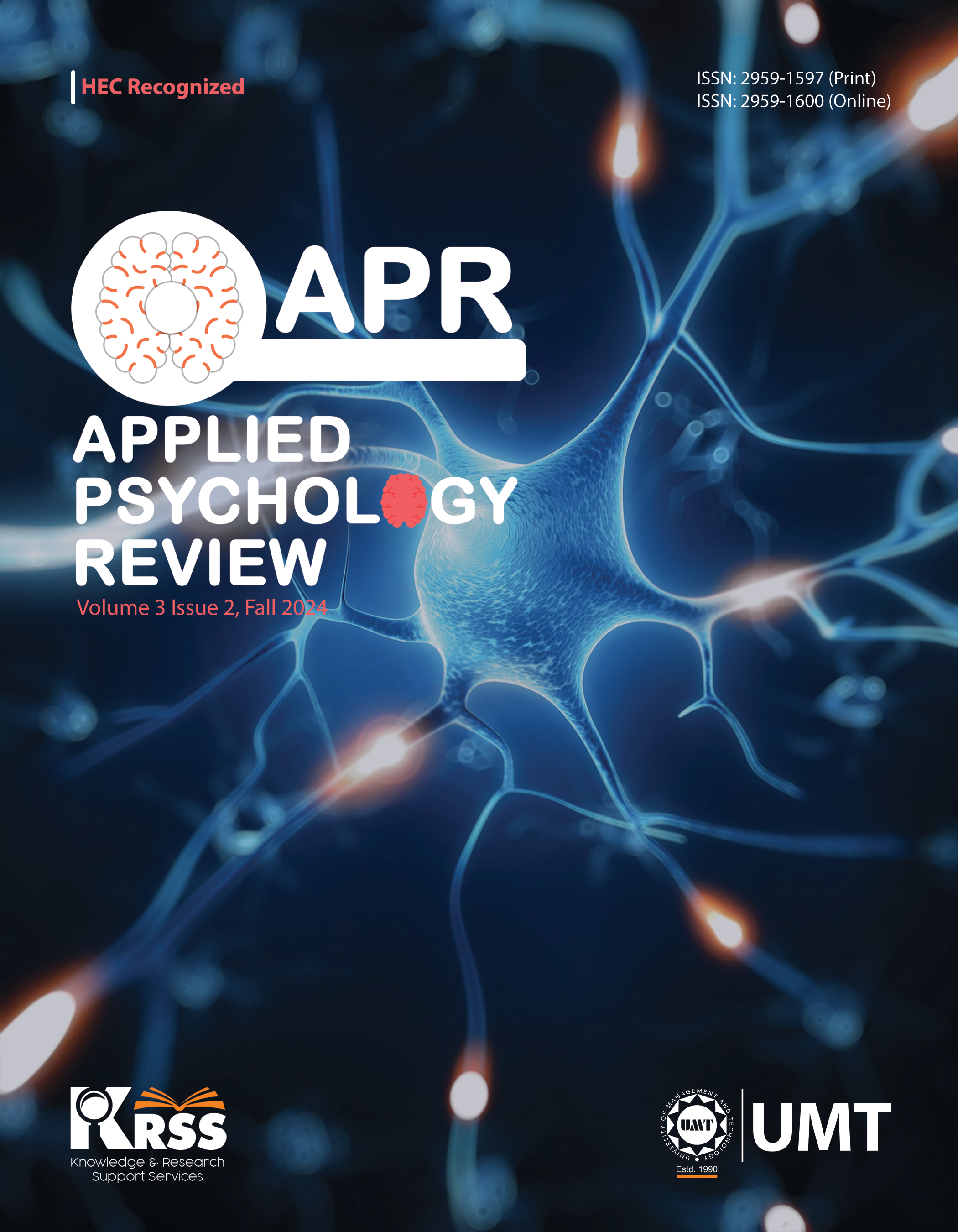Thought-Action Fusion, Scrupulosity and Afterlife Beliefs in Young Adults
Abstract
 Abstract Views: 0
Abstract Views: 0
The objective of this study was to examine the relationship between thought-action fusion and scrupulosity in young adults while investigating the mediating role of afterlife beliefs. The sample comprised of (N = 200) young adults, including men (n = 87) and women (n = 113). All the participants were Muslims with their age ranging between 18-35. To measure the constructs, Afterlife Belief Scale for Muslims, Penn Inventory of Scrupulosity-Revised, and Thought-Action Fusion Scale were used. The study data was analysed using SPSS and PROCESS Macro. Correlation analysis depicted that thought-action fusion and afterlife belief were significantly positively correlated with scrupulosity. Positive afterlife belief had a non-significant correlation with thought-action fusion. Mediation analysis confirmed the mediating role of afterlife belief in the relationship between thought-action fusion and scrupulosity. The present study has significant implications in the clinical and counselling field. The practitioners can consider a person’s afterlife belief system while dealing with the religious manifestations of OCD and scrupulosity; hence they can apply more effective therapeutic interventions according to the mediation model.
Downloads
References
Abdel-Khalek, A. M. (2014). Religiosity and well-being in a Muslim context. In C. Kim-Prieto (Ed.), Religion and spirituality across cultures (pp. 71–85). Springer Netherlands. https://doi.org/10.1007/978-94-017-8950-9_4
Abramowitz, J. S. (2008). Treatment of scrupulous obsessions and compulsions using exposure and response prevention: A case report. Cognitive and Behavioural Practice, 8(1), 79-85. https://doi.org/10.1016/S1077-7229(01)80046-8
Abramowitz, J. S., & Deacon, B. J. (2006). Psychometric properties and construct validity of the obsessive-compulsive inventory-revised: Replication and extension with a clinical sample. Journal of Anxiety Disorders, 20(8), 1016–1035. https://doi.org/10.1016/j.janxdis.2006.03.001
Altin, M. U. (2009). A cross cultural investigation of obsessive-compulsive symptomatology: The role of religiosity and religious affiliation [Unpublished doctoral dissertation]. Middle East Technical University, Turkey.
Altin, M., & Gençöz, T. (2011). How does thought-action fusion relate to responsibility attitudes and thought suppression to aggravate the obsessive-compulsive symptoms? Behavioural and Cognitive Psychotherapy, 39(1), 99–114. https://doi.org/10.1017/S1352465810000524
Amjad, A. (2014). Death anxiety as a function of age and religiosity. Journal of Applied Environmental and Biological Sciences, 4(9), 333–341.
Benore, E. R., & Park, C. L. (2004). Invited essay: Death specific religious beliefs and bereavement: Belief in an afterlife and continued attachment. The International Journal for the Psychology of Religion, 14(1), 1–22. https://doi.org/10.1207/s15327582ijpr1401_1
Flannelly, K. J., Ellison, C. G., Galek, K., & Koenig, H. G. (2008). Beliefs about life after death, psychiatric symptomolgy and cognitive theories of psychopathology. Journal of Psychology and Theology, 36, 94–103. https://doi.org/10.1177/009164710803600202
Ghayas, S., & Batool, S. S. (2016). Construction and validation of afterlife belief scale for Muslims. Journal of Religion and Health, 56, 861–875. https://doi.org/10.1007/s10943-016-0258-z
Hayes, A. F. (2013). Introduction to mediation, moderation, and conditional process analysis: A regression-based approach. Guilford Press.
Hezel, D. M., Stewart, S. E., Riemann, B. C., & McNally, R. J. (2019). Clarifying the thoughtaction fusion bias in obsessive-compulsive disorder. Journal of Obsessive-Compulsive and Related Disorders, 20, 75–84. https://doi.org/10.1016/j.jocrd.2017.10.004
Hood, R. W., Hill, P. C., & Williamson, W. P. (2005). The psychology of religious fundamentalism. Guilford Press.
Kabakcı, E., Demir, B., Demirel, H., & Şevik, A. E. (2008). Thought–action fusion: Is it present in schizophrenia? Behaviour Change, 25(3), 169–177. https://doi.org/10.1375/bech.25.3.169
Lee, E. B., Barney, J. L., Twohig, M. P., Lensegrav-Benson, T., & Quakenbush, B. (2020). Obsessive compulsive disorder and thought action fusion: Relationships with eating disorder outcomes. Eating Behaviors, 37, Article e101386. https://doi.org/10.1016/j.eatbeh.2020.101386
Lee, H. J., Cougle, J. R., & Telch, M. J. (2005). Thought–action fusion and its relationship to schizotypy and OCD symptoms. Behaviour Research and Therapy, 43(1), 29–41. https://doi.org/10.1016/j.brat.2003.11.002
Maududi, S. A. (1984). Islam: Its meaning and message. In M. T. Quraishi (Ed.), Islam: A way of life and a movement (pp. 9–33). American Trust Publications.
Miller, C. H., & Hedges, D. W. (2008). Scrupulosity disorder: An overview and introductory analysis. Journal of Anxiety Disorders, 22(6), 1042–1058. https://doi.org/10.1016/j.janxdis.2007.11.004
Muris, P., Meesters, C., & Rassin, E. (2001). Thought-action fusion and anxiety disorder symptoms in normal adolescents. Behavior Research and Therapy, 39, 843–852. https://doi.org/10.1016/s0005-7967(00)00077-2
Nelson, E. A., Abramowitz, J. S., Whiteside, S. P., & Deacon, B. J. (2006). Scrupulosity in patients with obsessive–compulsive disorder: Relationship to clinical and cognitive phenomena. Journal of Anxiety Disorders, 20, 1071–1086. https://doi.org/10.1016/j.janxdis.2006.02.001
Noureen, S. (2017). Relationship between religiosity and psychopathological symptomology: Role of God imagery and afterlife belief among university students [Unpublished master’s thesis]. University of Sargodha, Pakistan.
Obayashi, H. (1992). Death and afterlife: Perspective of world religions. Greenwood Press.
Olatunji, B. O., Abramowitz, J. S., Williams, N. L., Connolly, K. M., & Lohr, J. M. (2007). Scrupulosity and obsessive-compulsive symptoms: Confirmatory factor analysis and validity of the Penn Inventory of Scrupulosity. Journal of Anxiety Disorders, 21(6), 771–787. https://doi.org/10.1016/j.janxdis.2006.12.002
Pearson, A. M. (1998). Hinduism. In J. C. Johnson & M. G. McGee (Eds.), How different religions view death and afterlife. (pp. 109–131). The Charles Press.
Rassin, E., & Koster, E. (2003). The correlation between thought-action fusion and religiosity in a normal sample. Behaviour Research and Therapy, 41, 361–368. https://doi.org/10.1016/s0005-7967(02)00096-7
Reuman, L., Buchholz, J., Blakey, S., & Abramowitz, J. S. (2017). Uncertain and fused: Uognitive fusion, thought-action fusion, and the intolerance of uncertainty as predictors of obsessive-compulsive symptom dimensions. Journal of Cognitive Psychotherapy, 31(3), 191–203. https://doi.org/10.1891/0889-8391.31.3.191
Reynolds, F. E. (1992). Death as threat, death as achievement: Buddhist perspectives with particular reference to the Theravada tradition. In H. Obayashi (Ed.), Death and afterlife (pp. 157–167). Greenwood Press.
Salkovskis, P. M. (1985). Obsessional-compulsive problems: A cognitive-behavioural analysis. Behaviour Research and Therapy, 23(5), 571–583. https://doi.org/10.1016/0005-7967(85)90105-6
Shafran, R., & Rachman, S. (2004). Thought-action fusion: A review. Journal of Behavior Therapy and Experimental Psychiatry, 35(2), 87–107. https://doi.org/10.1016/j.jbtep.2004.04.002
Shafran, R., Thordarson, D. S., & Rachman, S. (1996). Thought-action fusion in obsessive-compulsive disorder. Journal of Anxiety Disorders, 10, 379–391. https://doi.org/10.1016/0887-6185(96)00018-7
Simkus, J. (2024, January 22). Scrupulosity OCD: When religious or moral beliefs become OCD. Simply Psychology. https://www.simplypsychology.org/scrupulosity-ocd-when-religious-or-moral-beliefs-become-ocd.html
Thompson-Hollands, J., Farchione, T. J., & Barlow, D. H. (2013). Thought-action fusion across anxiety disorder diagnoses: Specificity and treatment effects. The Journal of Nervous and Mental Disease, 201(5), Article e407. https://doi.org/10.1097/NMD.0b013e31828e102c
Williams, A. D., Lau, G., & Grisham, J. R. (2013). Thought-action fusion as a mediator of religiosity and obsessive-compulsive symptoms. Journal of Behavior Therapy and Experimental Psychiatry, 44(2), 207–212. https://doi.org/10.1016/j.jbtep.2012.09.004
Witzig, T. F. (2005). Obsessional beliefs, religious beliefs, and scrupulosity among fundamental protestant Christians. Journal of Obsessive Compulsive and Related Disorders, 2(3), 331–337. https://doi.org/10.1016/j.jocrd.2013.06.002
Yorulmaz, O., Karanci, A. N., Bastug, B., Kisa, C., & Goka, E. (2008). Responsibility, thought action fusion, and thought suppression in Turkish patients with obsessive–compulsive disorder. Journal of Clinical Psychology, 64(3), 308–317. https://doi.org/10.1002/jclp.20460
Copyright (c) 2024 Muhammad Usama Gondal, Sadia Malik

This work is licensed under a Creative Commons Attribution 4.0 International License.




